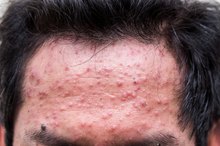Symptoms of an MRSA Infection on the Face
MRSA, which stands for Methicillin-resistant Staphylococcus aureus, is a drug-resistant version of the staphyloccocus bacteria. Therefore, it is known as a "super bug." MRSA is a very serious yet treatable infection that requires immediate medical attention. Consult your medical professional if you note any of the following symptoms.
History
MRSA is a strain of the staph bacteria that was first discovered in 1961. Over the years, it has developed a resistance to common antibiotics.
Identification
Symptoms of Infantigo
Learn More
A wound infected with MRSA is a red, pus-filled, swollen area resembling a pimple, boil or abscess. It is quite painful. Staph is commonly found on the body, especially in the nose, but becomes an infection when it enters a cut or open sore.
Misconceptions
MRSA infections are often confused for spider bites. In the beginning, they can also be confused for pimples.
Warning Signs
What Is the Difference Between Cellulitis & Mrsa?
Learn More
Immediately call your doctor if you are being treated for a staph infection and it isn't clearing up or gets worse after about three to four days. Call if you develop a new fever or if your current fever worsens.
Rare Forms
In a rare form of MRSA, it becomes necrotizing fasciitis, which is "flesh-eating" bacteria.
Related Articles
Resources
Writer Bio
Andrea Coventry has been writing online since 2007. Her expertise includes teaching, working with children and Montessori schools. Her work has appeared in various online publications. Coventry is certified by the American Montessori Society.








